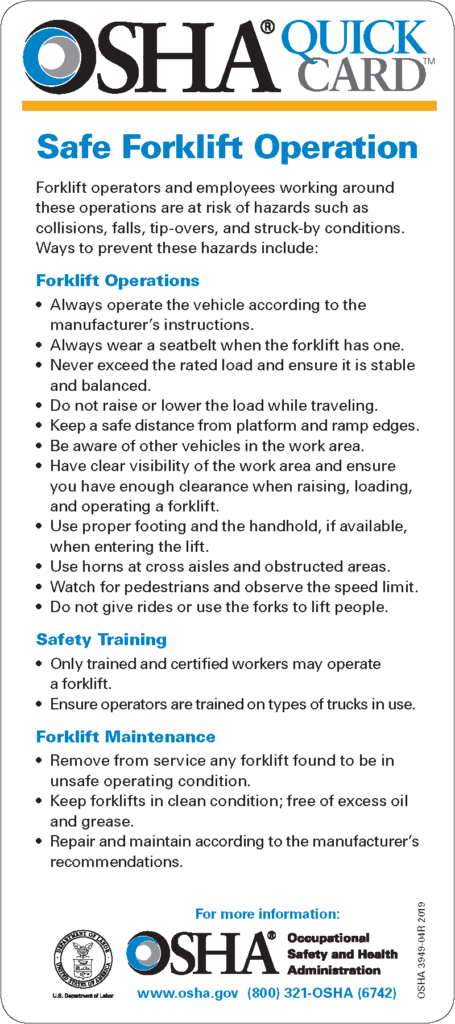Provide these safety tips for forklift operation to your warehousing and construction clients
Forklifts are one of the most commonly used pieces of equipment in construction and warehousing. These powered industrial trucks are used to lift and transport heavy loads. With more than a million forklifts estimated to be in operation, it’s essential to ensure crews are trained on proper forklift operation safety measures.
OSHA estimates that forklift accidents cause close to 35,000 serious injuries and 85 fatal accidents every year. Fully one quarter of these accidents result from inadequate training. Some common risks include tip-overs, collisions, falls and struck-by conditions. Factors like unstable terrain, new attachments or poorly ventilated work zones can impede forklift operation safety and increase the risk of accidents and fatalities.
Related: Top 13 preventable workplace injuries [infographic]
Insurance agents, share these forklift operation safety tips with your insureds and encourage them to continually share them with their employees. View our five steps below to see what forklift hazards to avoid and safety tips to enact.
- Require forklift certification for your drivers. This training and certification will surpass any additional training that employers can provide. The licensing includes OSHA standards and can be completed online. Google “forklift training” to see what’s available in your area. Big Rentz suggests that employers evaluate forklift drivers’ performance at least every three years and supplement training with forklift safety videos, software training and demonstrations.
2. Inspect your forklifts daily. Procedures differ depending on if your equipment is powered by electricity or propane, or if yours is an electric transtacker, a yard forklift, a riding grip tow, stand-up riding tow tractor and more. View daily procedures for each on OSHA’s website. Various attachments may also present risks because they cause a shift in the forklift’s center of gravity and may reduce its carrying capacity. Also, look for worn forks, stretched chains and other worn-out parts that may result in an accident.
3. Speed and maneuvering hazards. Carrying a heavy load at high speeds creates momentum that’s hard to stop. Insist that forklift operators follow all posted speed limits and drive cautiously. Narrow or cluttered aisles, blind spots and high pedestrian traffic all create risks. Plus, a fully loaded forklift can obstruct the driver’s forward view, necessitating that they drive in reverse. Rear-end steering makes the forklift take tight turns in the front but swing wide in the back. Drivers always need a spotter when encountering blind spots. Here are additional safety tips:
– When driving, keep forks low to the ground for forward visibility.
– Always look in the direction you’re traveling; use rearview mirrors to increase your visibility.
– Ensure you have a good view of the rack when you’re positioning the load.
– Always make eye contact with other workers.
4. Pay attention to load hazards. The weight and security of the load can cause its own set of risks. Ensure the materials are under the weight capacity and are safely secured before moving. Not doing so can result in tip-overs or other accidents. Also train employees to use extra caution when carrying hazardous materials to avoid a spill that might endanger the entire area.
5. Dealing with the hazards of poor lighting, floor conditions and bad weather. Forklift drivers should always inspect their route before driving it, removing obstacles (including people) and debris, and noting uneven or unstable ground, puddles and ramps. They must also know their forklift’s dimensions for tight maneuverability.
Related: OSHA’s top 10 violations for 2022 [infographic]
Ensure your workers follow these hazard alerts and forklift operation safety tips to prevent accidents. View additional tips from OSHA in the infographic below.


![You are currently viewing Forklift operation safety [infographic]](https://www.arrowheadgrp.com/wp-content/uploads/2023/10/AH-Forklift-BLOG.png)